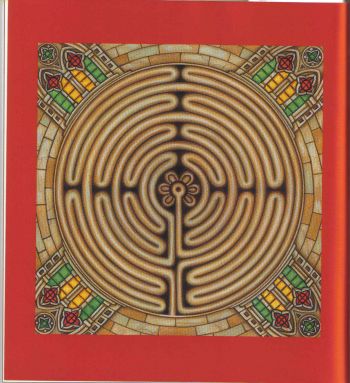
In the opening section we talked about medicine wheels. “An odd variation sometimes found in medicine wheels is the presence of a passageway, or a doorway, in the circles. The outer ring of stones will be broken, and there will be a stone path leading up to the center of the wheel.” http://en.wikipedia.org/wiki/Medicine_wheel. And so we introduced the concept of a labyrinth! Walking a labyrinth, whether it is on foot or with a portable labyrinth using your finger or wooden tracer stick, is a meditative process inviting introspection. It is very relaxing.
“What is a Labyrinth?
A labyrinth is a single path or unicursal tool for personal, psychological and spiritual transformation. Labyrinths are thought to enhance right brain activity.
The Classical Seven Circuit Labyrinth in this example shows that you enter a labyrinth through the mouth and then walk on the paths or circuits. The walls keep you on the path. The goal is in the center of the labyrinth. When you reach it, you have gone half the distance – you now need to turn around and walk back out.” http://labyrinthsociety.org/about-labyrinths. This site is also has a link to a world-wide labyrinth locator! How cool is that? Who knew Minnesota had so many labyrinths? You can also use their look-up function to look-up portable labrynths! All worth checking out!
Below is a mandala of a labyrinth for your meditation to go. Enjoy!
Using Mandalas as a meditative practice: Circular mandalas have been used as a meditative practice for centering the mind. This refers to the symbolic power of geometrical shapes as a point of meditative focus. You gaze first at the mandala, with eyes open for as long as is comfortable, imbedding the image into memory so you can then focus upon the intricacies as a mental image with eyes closed focusing inward.
David Fontana has two books that are great references for a meditation practice, and the second one specifically for using Mandalas as a form of meditation: The Meditator’s Handbook as well as Meditating with Mandalas—the example I use below. The latter book contains many beautiful geometric mandalas to use in your meditations if you find this type of meditation is something you’d like to look into further.
“In meditation, yantras (another name for a type of mandala) also focus the meditator’s energies, not only by acting as a point of concentration but also by operating upon the unconscious through the symbolic meaning of the shapes they contain.” (The Meditator’s Handbook.)

The Pilgrim’s Maze
The Labyrinth was once a symbol of moral confusion, but in the middle ages Christians began to see it as the true way of belief. This mandala is based on the maze on the floor of Chartres Cathedral, France.
1. Follow the labyrinth from its entrance (at the bottom) all the way to the floral device at its center. You should not lose your way, because the labyrinth is unicursal—that is, it has no junctions. But if you forget where you are, go back to the start and try again.
2. As you get closer to the center, imagine travelling deeper into the self. The labyrinth is your physical incarnation, the life you lead on Earth; and, at the same time, it is the challenges that you face in following your spiritual destiny.
3. Once you reach the center, view it as a tunnel that leads down into the page. Step into this tunnel. For many, the labyrinth continues, but for you the path is now straight—as long as you keep the purity of heart that your pilgrimage has brought you.
Source: The Meditator’s Handbook as well as Meditating with Mandalas, by David Fontana.
About the author, David Fontana: “Dr. David G. J. Fontana, Ph.D, FBPS (1934 – 18 October 2010) was a British academic, psychologist and author. He was Professor of Psychology at the Cardiff University. He was also visiting professor at John Moores University and the University of the Algarve.
Born in Middlesex, Fontana was a Fellow of the British Psychological Society, a Chartered Psychologist and a Chartered Counseling Psychologist. He published more than 45 books, including popular treatments of dreams and symbols.
Fontana took an interest in paranormal research such as mediumship, poltergeist cases and Electronic voice phenomena, and was at one time president of the Society for Psychical Research, from 1995-98.
Fontana, together with Ingrid Slack and Martin Treacy in 1996, established a Transpersonal Psychology Section within the British Psychological Society, adding academic credibility to this school of thought at the fringe of academic psychology. Fontana attended the annual conferences of the Transpersonal Section of the British Psychological Society, which, for the first two years, were in Birmingham, and from 1999 onwards, generally took place at Cloughton, near Scarborough, North Yorkshire.
He served as the first president of the British Psychological Society’s Transpersonal Section, a post he held from 1996-2001. His primary academic affiliation was at Cardiff University, where he was Distinguished Visiting Fellow. He wrote on such topics as education, Buddhism, meditation and mindfulness, dreams, symbols, the psychology of religion, Christianity and survival.” http://www.amazon.com/David-Fontana/e/B000AQ26QA/ref=ntt_dp_epwbk_0
If you found the above interesting, please consider taking my meditation “how to” classes. Visit my Web-site for details.

